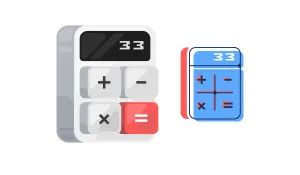Understanding your pay on an hourly basis is one of the most useful financial comparisons you can make. Knowing the true hourly rate of your annual salary helps you compare job offers, calculate the worth of overtime, or gauge the cost of time off.
This calculation relies on a single, universally accepted number for a standard work year: 2,080 hours. We show you the simple formula and how to use it.
Part 1: The Core Formula and the 2,080 Rule
The calculation for converting your annual salary to an estimated hourly wage is straightforward:
$Hourly Wage = Annual Salary / Total Working Hours Per Year
The 2,080-Hour Standard
For most full-time jobs in the United States, the standard work year is calculated as 2,080 hours. This number is derived by taking the typical work schedule and multiplying it by the total weeks in a year:
40 hours per week x 52 weeks per year = 2,080 hours
This 2,080 figure is the base number used by payroll departments to set salaried compensation and benefit costs. It assumes you work every week of the year and does not subtract holidays, vacation time, or sick days.
Part 2: Step-by-Step Calculation Examples
You only need two pieces of information to perform this calculation: your gross annual salary (before taxes) and the number of hours you work per week.
Example 1: Standard 40-Hour Week
Let's say your annual salary is $60,000 and you work the standard 40 hours per week.
- Find Total Annual Hours: 40 x 52 = 2,080 hours
- Divide Salary by Hours: $60,000 divided by 2,080 hours
- Result: Your estimated hourly wage is $28.85 per hour.
Example 2: Non-Standard Work Week
Now, let's say your salary is $85,000, but your job requires an average of 50 hours per week.
- Find Total Annual Hours: 50 x 52 = 2,600 hours
- Divide Salary by Hours: $85,000 divided by 2,600 hours
- Result: Your estimated hourly wage is $32.69 per hour.
This example shows the real benefit of the calculation: working ten extra hours each week reduces the effective hourly rate from what it would be at a standard 40-hour job.
Part 3: A Quick Mental Shortcut
Need a rough idea of your hourly wage without a calculator? Use this simple, easy-to-remember mental trick:
- Take your annual salary (in thousands).
- Divide that number by 2.
| Annual Salary | Thousands | Divide by 2 (Mental Estimate) | Actual Hourly Rate (Using 2,080) |
| $40,000 | 40 | $\$20$ | $19.23 |
| $80,000 | 80 | $\$40$ | $38.46 |
| $120,000 | 120 | $\$60$ | $57.69 |
This method is surprisingly close and works because 2,080 is roughly 2 times 1,000. It is a great way to quickly gauge the value of a job offer. Try it today!
Want a simple way to calculate it? Use our calculator below.
Try the Calculator
Annual Salary to Hourly Wage Calculator
Your Estimated Hourly Wage:
$...
Based on ... total annual hours.






